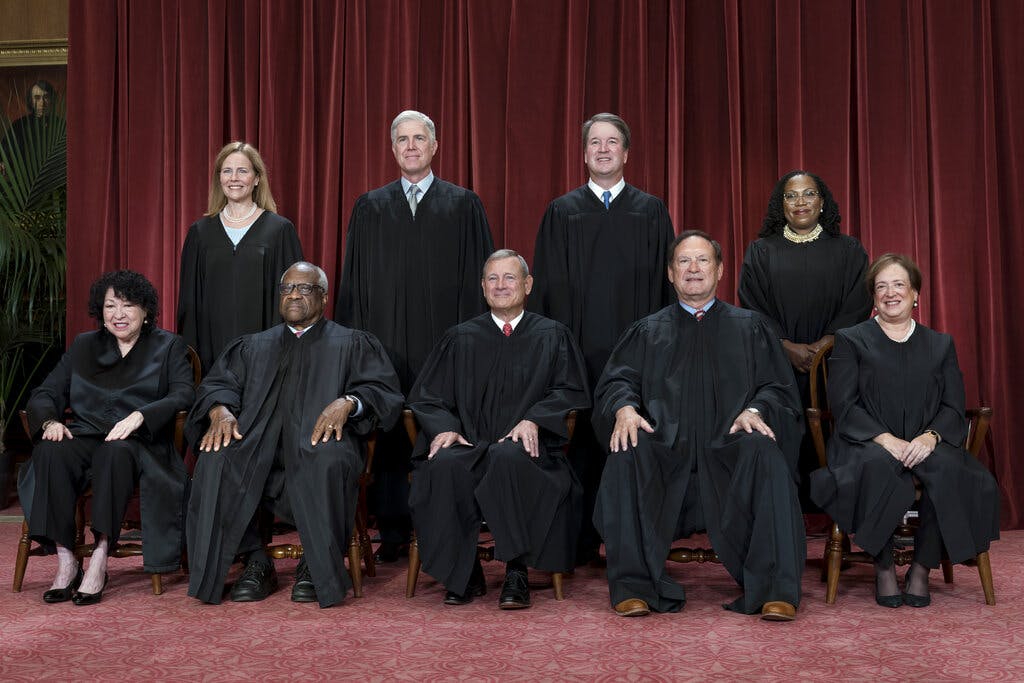Proposed Ethics Code for Supreme Court Escalates Campaign To Bind the Justices
Two advocacy groups release a scheme to regulate America’s highest court.

The release of a “Model Code of Conduct for U.S. Supreme Court Justices” by two good-government groups — Project for Government Oversight and Lawyers Defending Democracy — brings into sharp focus the growing effort to regulate the justices, a push that the Nine has thus far resisted.
Unlike lower court judges, who are bound by the Code of Conduct for United States Judges, Supreme Court sages are free to consult those rules but are not bound by them. The sole rule that reaches them is the one on recusal, which ostensibly requires both judges and justices to sit out hearing cases involving “personal bias” or “fiduciary” interest.
Recent speculation around recusal has centered on Justice Clarence Thomas, whose wife Virginia, or “Ginni,” is active in conservative political circles and was texting with President Trump’s chief of staff, Mark Meadows, on January 6, 2021. There have been calls for Justice Thomas to recuse himself from cases related to that day.
The court’s newest justice, Ketanji Brown Jackson, recused herself from one of this term’s marquee cases, Student for Fair Admission v. Harvard, because she served on the school’s Board of Overseers. She sat for its companion case involving the University of North Carolina. Justice Elena Kagan, who served as the dean of Harvard Law School, did not step aside.
The “Model Code” avers that the “absence of an explicit Supreme Court code of conduct has allowed multiple ethical lapses to occur without any repercussions,” a situation it describes as “untenable” given the justices’ status as “among the most powerful government officials in the country.” It cites the American Bar Association’s call for a binding code of ethics.
The “Model Code” takes direct aim at what Chief Justice Rehnquist called the “duty to sit,” the principle that a justice has a responsibility to work. It proposes that “no Justice should sit on a case when their impartiality might be reasonably questioned, irrespective of the impact of their disqualification on the Court’s ability to hear a case.”
Chief Justice Rehnquist thought differently, articulating a “duty to sit where not disqualified which is equally as strong as the duty to not sit where disqualified.” That “equal duty” to sit is “even stronger in the case of a Justice of the Supreme Court” because they are so few in number, in contrast to the more than 800 lower court judges.
The court’s “ability to hear a case” is also material to Chief Justice Roberts, who opines that “partisan demands, public clamor or considerations of personal popularity or notoriety” have no place in recusal considerations. A “reasonableness” standard of the kind contemplated by the “Moral Code” would appear sensitive to precisely those kinds of considerations.
Not only could justices be disqualified for a “variety of circumstances,” but they would be required to “publish a written decision for recusal decisions.” Among the circumstances that the “Model Code” recognizes is “certain conduct by a spouse or other close family member.”
The “Model Code” would also call for justices to “refrain from participating in events that would cast doubt on their impartiality, including appearing before organizations with partisan or ideological agendas.” Justices on both the right and left regularly speak in front of such groups. No speaking arrangements would be allowed that are “closed to the public or media.”
Also proposed is a “new canon of judicial conduct that would create a duty of transparency.” The composers of the “Code” acknowledge that “these additional rules would undoubtedly place additional burdens” on the justices.
The executive director of another watchdog group, Gabe Roth, says that “Congress should start playing hardball” if the justices drag their feet on adopting such a code by taking a “serious look at whether the justices need upwards of $127 million in discretionary spending in the coming year.” That is how much the court requested from Congress last week.
Democrats in Congress last month re-introduced the Supreme Court Ethics, Recusal, and Transparency Act, sponsored by Representative Hank Johnson in the House and Sheldon Whitehouse in the Senate, the latter of whom laments how the “justices continue to shrug off their own self-imposed ethics crises.” The former, Mr. Johnson, was chairman of a committee that contemplated impeaching Justice Thomas.
Lawyers Defending American Democracy, which hopes that this draft is the first step toward a court that binds itself to a version of the code it proffers, takes as its motto the words of the ancient Rabbi Hillel: “If not us, who? If not now, then when?”

